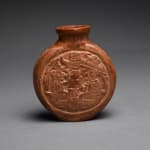Mayan Terracotta Poison Bottle, 500 CE - 900 CE
Terracotta
height 8.9 cm
height 3 1/2 in
height 3 1/2 in
PF.4543
Further images
It is impossible to overestimate the importance ritual and ceremony had on Maya society. To perform a sacred rite was the re-enactment of procedure and method in an exact sequence...
It is impossible to overestimate the importance ritual and ceremony had on Maya society. To perform a sacred rite was the re-enactment of procedure and method in an exact sequence choreographed precisely as an exquisite dance. Music, language and art played a crucial role in presenting a visual and audible structure within which the gods could communicate with mortals; and if successful, everyone could experience a transcendent moment of reality. This principal applies to any context where ritual is precisely followed, including matters, which touch only one individual at a time. The joy of discovering such gems as this lovely flask is that it brings us into direct contact with an esoteric symbolism that is, nonetheless, very human and exciting. Inscribed on both front and back is a scene where the same event is taking place. Two seated male figures face each other, separated by a column of glyphs. The one on the left is the God L, known as Lord One Death, seen smoking his characteristic cigar. He is facing another deity known as God K. This flask may have contained powdered pigments or other materials such as copal incense. If so, then it might have belonged to a painter. In fact, its size and shape is quite similar to containers of copal oil used by artists today. The inscribed scene, along with the glyphs, constitutes a vital part of the effectiveness of the liquid held within. Art as language could attract power through ritual and influence material things. A simple object thereby becomes something extraordinary, imbued with magic and otherworldly mystery used for the heavenly pursuit of painting.







